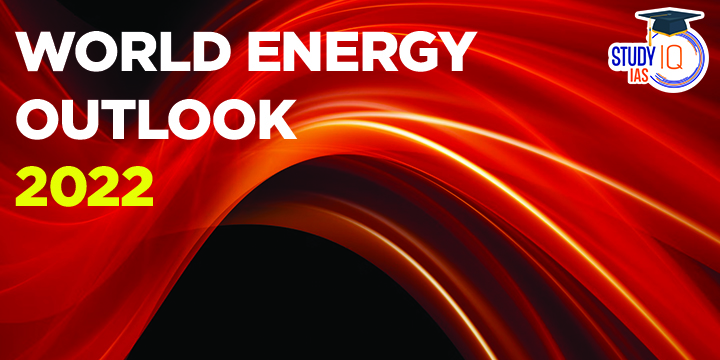Table of Contents
About World Energy Outlook 2022 IEA
World Energy Outlook is an annual publication the International Energy Agency (IEA), widely recognized as the most authoritative source for global energy projections and analysis.
World Energy Outlook 2022 provides critical analysis and insights on trends in energy demand and supply, and what they mean for energy security, environmental protection and economic development.
World Energy Outlook 2022 Report
- The World Energy Outlook 2022 analyzed the future global energy scenario by exploring through three different scenarios differentiated primarily by the assumptions made on government policies. They are:
- The Stated Policies Scenario (STEPS): It shows the trajectory implied by current policy measures on energy.
- The Announced Pledges Scenario (APS): It assumes that all aspirational targets announced by governments are met on time and in full, including their long-term net zero and energy access goals.
- The Net Zero Emissions by 2050 (NZE) Scenario: It maps out a way to achieve a 1.5 °C stabilization in the rise in global average temperatures, alongside universal access to modern energy by 2030.
World Energy Outlook 2022 Highlights
1. The Global Energy Crisis
- The world is in the middle of a global energy crisis of unprecedented depth and complexity.
- Europe is at the centre of this crisis, but it is having major implications for markets, policies and economies worldwide.
2. How is Russia’s Invasion of Ukraine Reshaping the Energy World?
- Energy markets: High and volatile energy prices are hurting households and businesses, shifting the choice of fuels and setting back progress towards achieving universal access to energy.
- Energy policy: Short-term responses have focused on securing available supply and protecting consumers, but many governments in the US, EU and elsewhere have adopted new policies that give a major boost to investments in clean energy and efficiency.
- Energy trade: European sanctions on coal and oil imports and Gazprom’s decisions to cut gas supply are triggering a profound reshuffling of trade flows around the world.
- Economic impacts: High fossil fuel prices are stoking inflationary pressures; the combination of falling real incomes and rising prices is creating a looming risk of global recession.
- The report says that while Russia’s invasion of Ukraine has caused a global energy crisis and is being seen as a setback to tackle climate change, it may also be an opportunity because of the governmental responses that have followed, such as the US’s Inflation Reduction Act which promotes clean energy, and India and China’s ambitious clean energy targets.
3. Outlook for Energy Demand
- Natural gas: High energy prices, heightened energy security concerns and strengthened climate policies are putting an end to a decade of rapid progression for natural gas; its annual demand growth slows to 0.4% from now to 2030 in the STEPS, down from 2.3% from 2010 to 2019.
- Coal: It sees a temporary surge in demand in some regions from the power and industry sectors in response to increases in natural gas prices, but efforts to reduce emissions soon put coal into decline again, ending the decade with demand 9% lower than
- Renewables: Notably solar PV and wind, gain the most ground of any energy source this decade, accounting for 43% of electricity generation worldwide in 2030, up from 28% today.
- Oil: The demand for oil rises 0.8% per year to 2030, but peaks soon after at around 103 million barrels per day as electric vehicles (EVs) and efficiency gains undermine its prospects.
World Energy Outlook: India Specific Findings
- Energy demand: India will witness the “largest increase in energy demand of any country”.
- India will have the highest population by 2025. This, along with urbanization and industrialization, will spur a huge rise in energy demand of more than 3% per year from 2021-2030, as per the STEPS scenario.
- Demand for coal: With just over 10% of global coal consumption, India is also the world’s second‐largest coal consumer today, the report said.
- Coal demand in India rose rapidly between 2010 and 2019, mainly as increases in electricity demand were largely met through coal‐fired power. Coal use in India dropped by 7% in 2020 due to the pandemic, but increased by 13% in 2021.
- This demand will peak anywhere between the late 2020s and early 2030s.
- However, the peak will be followed by a steep decline in coal demand as the deployment of renewables in the power sector picks up.
- Renewables: Government programmes such as the Gati Shakti National Master Plan and the Atmanirbhar Bharat Abhiyaan could promote a “robust growth” in renewables and electric mobility, notably for two/three‐wheelers.
- And by 2030, renewables will meet more than 60% of the growth in demand for power, and account for 35% of the electricity mix, with solar PV alone accounting for more than 15%.
- Net Zero by 2070: As per the APS, more rapid progress in deploying low‐emissions alternatives in power, industry and transport sectors in particular means that India could be within reach of its goal to achieve net zero emissions by 2070.
World Energy Outlook 2022 and IEA
- Establishment: The IEA was set up under the framework of the Organization for Economic Co-operation and Development (OECD) in the aftermath of the 1973 oil crisis to respond to physical disruptions in global oil supplies.
- Mission: To ensure reliable, affordable and clean energy for its member countries and beyond.
- Headquarters: Paris, France.
- Objectives:
- It provides policy recommendations, analysis and data on the entire global energy sector, with a recent focus on curbing carbon emissions and reaching global climate targets, including the Paris Agreement.
- It mainly focuses on its energy policies which include economic development, energy security and environmental protection. These policies are also known as the 3 E’s of IEA.
- Significance: The 31 member countries and 11 association countries of the IEA represent 75% of global energy demand.
- Key Publications:
- World Energy Outlook Report.
- World Energy Investment Report.
- World Energy Statistics.
- World Energy Balances.
- Energy Technology Perspectives.
- India Energy Outlook Report.


 India’s First Full-Stack Quantum Compu...
India’s First Full-Stack Quantum Compu...
 World Liver Day 2025, Theme, History, Ce...
World Liver Day 2025, Theme, History, Ce...
 Kailash Mansarovar Yatra to Resume Soon,...
Kailash Mansarovar Yatra to Resume Soon,...





















